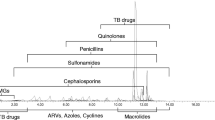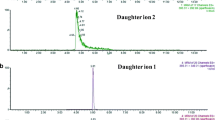Abstract
An ultra-high-performance liquid chromatography-tandem mass spectrometry (UHPLC-MS/MS) method was developed capable of simultaneously measuring chlortetracycline (CTC), epi-chlortetracycline, and isochlortetracycline (ICTC), as well as other structurally related tetracyclines in swine manure. A simple sample preparation was used consisting of extraction, dilution, centrifugation, and ultrafiltration. The concentrations of analyte were calculated using d6-tetracycline as an internal standard in the matrix-matched standard curve. A solvent gradient resolved the compounds in 3.5 min with an additional 1.5 min of re-equilibration allowing the analyses of a large number of samples in a short period of time. MS/MS was used as the detection method giving analyte confirmation in addition to a large dynamic range and low detection limit. The UHPLC-MS/MS method successfully resolved multiple degradation products of CTC from the complex manure matrix. The method detection limits ranged from 1.9 pg/μL for CTC to 7.3 pg/μL for ICTC, and the calibration curve was linear from 1 to 10,000 pg/μL. The method was tested by measuring CTC and its degradation products as a function of time in incurred swine manure that had been incubated at three different temperatures (22 °C, 38 °C, and 55 °C). CTC concentration at 22 °C decreased 44% after 25 days; greater percentage decreases were observed when the manure was stored at elevated temperatures (96% and 98% for 38 °C and 55 °C, respectively). The concentration of the microbiologically inactivate isomer, ICTC, increased over the incubation period. At 22 °C, ICTC continued to increase through 25 days of incubation; at 38 °C, ICTC concentration plateaued on day 14 while at 55 °C ICTC concentration plateaued on day 7, with concentration increases of 198%, 374%, and 282% for 22 °C, 38 °C, and 55 °C, respectively.

Fate of chlortetracycline in swine manure digesters




Similar content being viewed by others
References
National Animal Health Monitoring Service (2006) National Animal Health Monitoring Service swine report part II: reference of swine health and health management practices in the United States. NAHMS, Fort Collins
Wei R, Ge F, Huang S, Chen M, Wang R (2011) Occurrence of veterinary antibiotics in animal wastewater and surface water around farms in Jiangsu Province, China. Chemosphere 82:1408–1414
Cornick NA (2010) Tylosin and chlorotetracycline decrease the duration of fecal shedding of E. coli O157:H7 by swine. Vet Micro 143:417–419
Sharma R, Larney FJ, Chen J, Yanke LJ, Morrison M, Topp E, McAllister TA, Yu Z (2009) Selected antimicrobial resistance during composting of manure from cattle administered sub-therapeutic antimicrobials. J Environ Qual 38:567–575
Xie X, Zhou Q, He QZ, Bao Y (2010) Physiological and potential genetic toxicity of chlortetracycline as an emerging pollutant in wheat (Triticum avestivum L.). Environ Toxicol Chem 29:922–928
Kim SC, Carlson K (2007) Temporal and spatial trends in the occurrence of human and veterinary antibiotics in aqueous and river sediment matrices. Environ Sci Technol 41:50–57
Ok YS, Kim S, Kim K, Lee S, Moon SDH, Lim KJ, Sung J, Hur S, Yang JE (2011) Monitoring of selected veterinary antibiotics in environmental compartments near a composting facility in Gangwon Province, Korea. Environ Monit Assess 174:693–701
Loftin KA, Henny C, Adams CD, Surampali R, Mormile MR (2005) Inhibition of microbial metabolism in anaerobic lagoons by selected sulfonamides, tetracyclines, lincomycin, and tylosin tartrate. Environ Toxicol Chem 24:782–788
Kennedy DG, McCraken RJ, Carey MP, Blanchflower WJ, Hewitt SA (1998) Iso- and epi-iso-chlrotetracycline are the principal metabolites of chlortetracycline in the hen’s egg. J Chrom A 812:327–337
Ben W, Qiang Z, Adams C, Zhang H, Chen L (2008) Simultaneous determination of sulfonamides, tetracyclines and tiamulin in swine wastewater by solid-phase extraction and liquid chromatography-mass spectrometry. J Chrom A 1202:173–180
Frenich AG, Vidal JL, Pastor-Montoro E, Romero-Gonzalez R (2008) High-throughput determination of pesticide residues in food commodities by use of ultra-performance liquid chromatography-tandem mass spectrometry. Anal Bioanal Chem 390:947–959
Spisso BF, de Araújo MA, Monteiro MA, Lima AM, Pereira MU, Luiz RA, da Nóbrega AW (2009) A liquid chromatography-tandem mass spectrometry confirmatory assay for the simultaneous determination of several tetracyclines in milk considering keto-enol tautomerism and epimerization phenomena. Anal Chim Acta 656:72–84
Reinbold JB, Coetzee JF, Gehring R, Havel JA, Hollis LC, Olson KC, Apley MD (2009) Plasma pharmacokinetics of oral chlortetracycline in group fed, ruminating, Holstein steers in a feedlot setting. J Vet Pharmacol Therap 33:76–83
Yen JR, Wells JE, Miller DN (2004) Dried skim milk in growing-finishing diets: effects on growth performance. Apparent total tract nutrient digestibility, urinary and fecal nitrogen excretion, and carcass traits in pigs. J Anim Sci 82:3338–3345
Tylová T, Olšovská J, Novák P, Flieger M (2010) High-throughput analysis of tetracycline antibiotics and their epimers in liquid hog manure using ultra performance liquid chromatography with UV detection. Chemosphere 78:353–359
Hamscher G, Sczesny S, Höper H, Nau H (2002) Determine of persistent tetracycline residues in soil fertilized with liquid manure by high-performance liquid chromatography with electrospray ionization tandem mass spectrometry. Anal Chem 74:1509–1518
Hu XG, Luo Y, Zhou QX, Xu L (2008) Determination of thirteen antibiotics residues in manure by solid phase extraction and high performance liquid chromatography. J Anal Chem 36:1162–1166
Thomas MH (1989) Drug residues in animal tissues. J AOAC 72:564–567
Søeborg T, Ingerslev F, Halling-Sørensen B (2004) Chemical stability of chlortetracycline and chlortetracycline degradation products and epimers in soil interstitial water. Chemosphere 57:1515–1524
Bueno MJM, Hernando MD, Herrera S, Gomez MJ, Fernandez-Alba AR, Bustamante I, Garcia-Calvo E (2010) Pilot survey of chemical contaminants from industrial and human activities in river waters of Spain. Intern J Environ Anal Chem 90:321–343
Alvarez JA, Otero L, Omil LF (2010) The effect and fate of antibiotics during the anaerobic digestion of pig manure. Biores Tech 101:8581–8586
Stone JJ, Clay SA, Zhu Z, Wong KL, Porath LR, Spellman GM (2009) Effect of antimicrobial compounds tylosin and chlortetracycline during batch anaerobic swine manure digestion. Water Res 43:4740–4750
Bao Y, Zhou Q, Guan L, Wang Y (2009) Depletion of chlortetracycline during composting of aged and spiked manures. Waste Manage 29:1416–1423
Grote M, Vockel A, Schwarze D, Mehlich A, Freitag M (2004) Fate of antibiotics in food chain and environment originating from pig fattening (part 1). Fresenius Environ Bull 13:1216–1224
Acknowledgment
The authors wish to acknowledge Amy McGarvey for technical assistance and Jason Holthusen for LC-MS/MS operation.
Author information
Authors and Affiliations
Corresponding author
Additional information
Names are necessary to report factually on available data; however, the USDA neither guarantees nor warrants the standard of the product, and the use of the name by USDA implies no approval of the product to the exclusion of others that may also be suitable. USDA is an equal-opportunity provider and employer.
Rights and permissions
About this article
Cite this article
Shelver, W.L., Varel, V.H. Development of a UHPLC-MS/MS method for the measurement of chlortetracycline degradation in swine manure. Anal Bioanal Chem 402, 1931–1939 (2012). https://doi.org/10.1007/s00216-011-5637-4
Received:
Revised:
Accepted:
Published:
Issue Date:
DOI: https://doi.org/10.1007/s00216-011-5637-4




